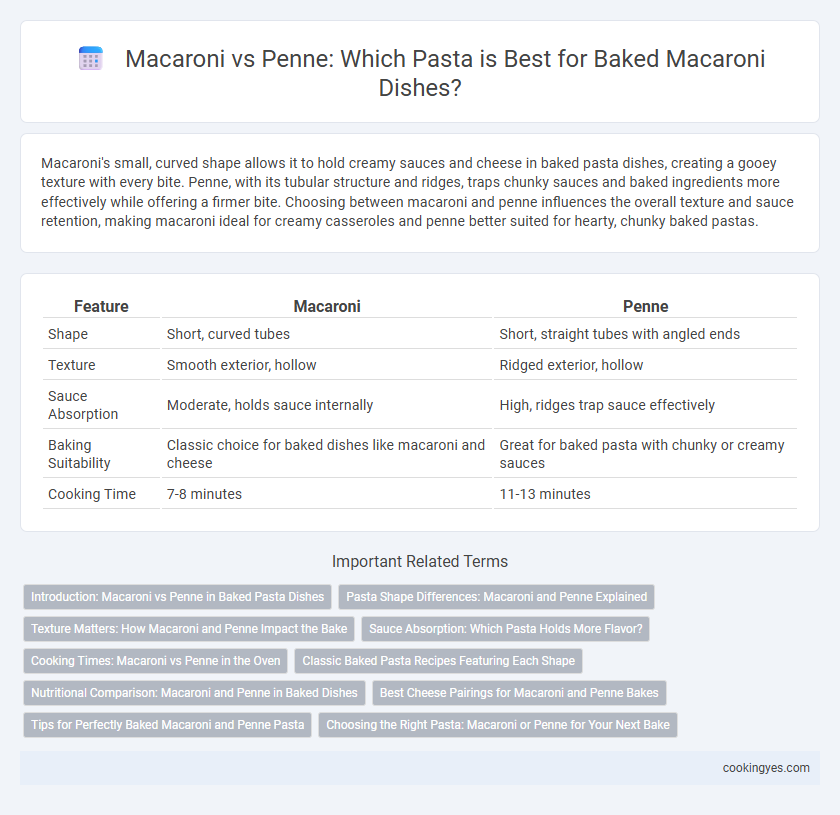Macaroni's small, curved shape allows it to hold creamy sauces and cheese in baked pasta dishes, creating a gooey texture with every bite. Penne, with its tubular structure and ridges, traps chunky sauces and baked ingredients more effectively while offering a firmer bite. Choosing between macaroni and penne influences the overall texture and sauce retention, making macaroni ideal for creamy casseroles and penne better suited for hearty, chunky baked pastas.
Table of Comparison
| Feature | Macaroni | Penne |
|---|---|---|
| Shape | Short, curved tubes | Short, straight tubes with angled ends |
| Texture | Smooth exterior, hollow | Ridged exterior, hollow |
| Sauce Absorption | Moderate, holds sauce internally | High, ridges trap sauce effectively |
| Baking Suitability | Classic choice for baked dishes like macaroni and cheese | Great for baked pasta with chunky or creamy sauces |
| Cooking Time | 7-8 minutes | 11-13 minutes |
Introduction: Macaroni vs Penne in Baked Pasta Dishes
Macaroni and penne each offer distinct textures and shapes that impact baked pasta dishes. Macaroni's small, curved tubes create a tender, cohesive bite absorbing cheese and sauce evenly, making it ideal for classic casseroles like macaroni and cheese. Penne's larger, ridged tubes provide a sturdier texture and hold thicker sauces well, lending structure and a hearty mouthfeel to baked pasta recipes.
Pasta Shape Differences: Macaroni and Penne Explained
Macaroni features a short, curved tubular shape, ideal for capturing cheese and sauce in baked pasta dishes due to its hollow center and smooth surface. Penne, distinguished by its cylindrical tubes with diagonal cuts and ridged texture, allows sauce to cling better and offers a firmer bite, enhancing texture in baked recipes. The choice between macaroni and penne impacts sauce retention and overall mouthfeel, making shape a key factor in baked pasta preparation.
Texture Matters: How Macaroni and Penne Impact the Bake
Macaroni's hollow, curved shape allows it to hold sauce and cheese within its tubes, creating a creamy, tender texture that melts beautifully in baked pasta dishes. Penne's ridged surface and larger diameter provide a firmer bite and better sauce adherence, resulting in a slightly chewier and more textured bake. Choosing macaroni enhances softness and sauciness, while penne adds structural contrast and a satisfying al dente finish to baked pasta meals.
Sauce Absorption: Which Pasta Holds More Flavor?
Macaroni's curved, hollow shape allows it to trap sauces efficiently, making it ideal for baked dishes with thick, creamy sauces that cling to its surface. Penne's ridged exterior and tubular form absorb sauce deeply, delivering a rich flavor in every bite while maintaining a firm texture. For baked pasta, penne holds more flavor due to its superior surface area and ridges that capture and retain sauce better than the smooth macaroni.
Cooking Times: Macaroni vs Penne in the Oven
Macaroni typically requires a shorter baking time in the oven compared to penne due to its smaller, thinner shape that heats through more quickly. Penne's tubular, thicker structure retains moisture longer, often necessitating an extended baking time to achieve a fully cooked, tender texture. Adjusting oven times accordingly ensures optimal pasta consistency for baked dishes featuring either macaroni or penne.
Classic Baked Pasta Recipes Featuring Each Shape
Classic baked pasta recipes highlight distinct textures between macaroni and penne, with macaroni offering a tender, hollow bite that expertly absorbs creamy cheese sauces, ideal for traditional mac and cheese dishes. Penne's ridged, tubular shape provides a sturdier texture, capturing chunky tomato-based or meat sauces perfectly in recipes like baked ziti or penne al forno. Both pastas excel in baked dishes, but penne's structure suits hearty, layered casseroles, while macaroni complements smoother, creamier preparations.
Nutritional Comparison: Macaroni and Penne in Baked Dishes
Macaroni and penne both offer comparable calorie counts and carbohydrate levels in baked pasta dishes, with slight variations depending on portion size and sauce ingredients. Macaroni tends to have a slightly lower glycemic index, which may be beneficial for blood sugar control compared to penne. Protein and fiber content remain relatively similar, making either pasta a balanced choice nutritionally when baked with cheese and tomato-based sauces.
Best Cheese Pairings for Macaroni and Penne Bakes
Macaroni's hollow, curved shape captures creamy cheeses like sharp cheddar and mozzarella, enhancing baked pasta dishes with smooth, melty textures. Penne's ridged surface holds robust cheeses such as Parmesan and provolone, which add a savory, slightly nutty flavor to baked dishes. Both pastas pair well with ricotta and fontina, but choosing cheddar or mozzarella elevates macaroni bakes, while penne benefits from harder, aged cheeses for a rich, layered taste.
Tips for Perfectly Baked Macaroni and Penne Pasta
For perfectly baked macaroni and penne pasta, choose pasta brands that hold their shape and texture after baking, such as Barilla or De Cecco. Boil pasta to al dente to prevent mushiness and ensure even sauce absorption during baking. Use a combination of mozzarella and Parmesan cheese for a golden, crispy topping that complements both macaroni and penne dishes.
Choosing the Right Pasta: Macaroni or Penne for Your Next Bake
Macaroni's small, curved tubes trap cheese and sauce effectively, making it ideal for creamy baked pasta dishes like classic macaroni and cheese. Penne's larger, ridged tubes hold chunky sauces and bake evenly, providing a hearty texture perfect for layered casseroles. Selecting macaroni enhances a smooth, cohesive bake, while penne offers a robust bite and sauce retention in baked pasta recipes.
Macaroni vs Penne for Baked Pasta Infographic

 cookingyes.com
cookingyes.com